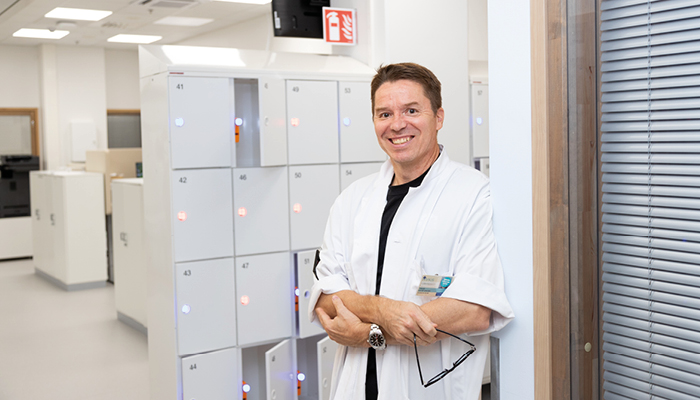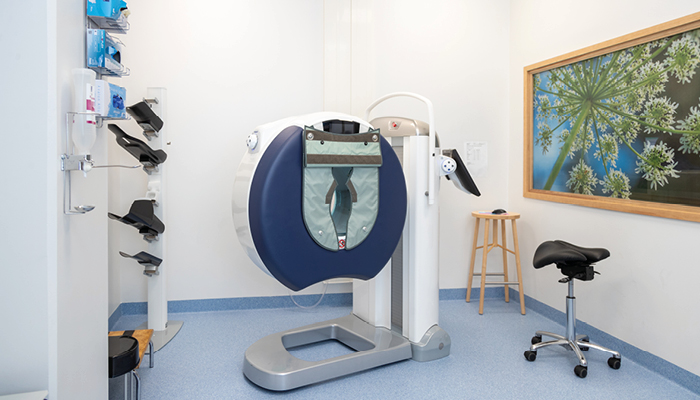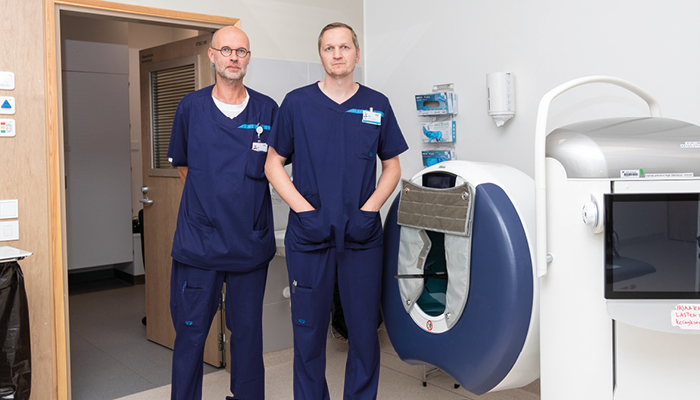Cutting-edge technology for 3D imaging – Planmed Verity® CBCT scanner in action at Finnish Meilahti Bridge Hospital
Since 2010, the Planmed Verity® extremity CBCT scanner has been a crucial tool for HUS Helsinki University Hospital. With over a decade of use, the medical staff are extremely satisfied with the device’s performance and mobile advantages both in elective care and in the emergency department.
The Planmed Verity® extremity cone-beam CT scanner has been in active use at the HUS Helsinki University Hospital – the largest health care provider in Finland – since 2010. The scanner was first taken into use at Töölö Hospital, which was specialized in orthopedic surgery, hand surgery, traumatology, and neurosurgery. After the closure of Töölö Hospital in the spring of 2023, the device was transferred to the elective department of the new Meilahti Bridge Hospital. At the same time, HUS acquired another Planmed Verity unit for the emergency department of the hospital.
With well over 10 years of experience with the Planmed Verity unit, Radiologist-in-Chief of HUS Diagnostic Center and Specialist in Musculoskeletal Radiology, Ville Haapamäki, and radiographers Mari Kankare and Satu Kupari are satisfied with the performance of the device. The advantages of the mobile CT scanner have not gone unnoticed by Deputy Nurse Managers Mika Nieminen and Kaj Ceder either. They both work at the emergency department of the brand-new hospital.
According to Ville Haapamäki, Radiologist-in-Chief of HUS Diagnostic Center, the high-quality 3D images provided by the Planmed Verity® CBCT scanner provide excellent diagnostic value.
How did you end up acquiring the Planmed Verity® CBCT scanner, first at Töölö Hospital and later at the new Bridge Hospital?
Ville Haapamäki: As an emergency medical device, Planmed Verity is amazing. It filled an ecological niche that was waiting to be occupied. In other words, we needed a low-dose imaging unit that delivers CT-level image data of the wrist, ankles and other peripheral joints, where a standard X-ray image does not provide enough information.
If we think about quite complex fractures that extend into the joint, then, in the past, they were practically always imaged with an ordinary CT device. The radiation doses were significantly higher than with the Planmed Verity CBCT scanner.
The mobile extremity scanner specifically caters to the needs of hand and orthopedic surgeons in the emergency department. In addition, it works very well in post-surgery, non-emergency follow-up imaging as well as in the imaging of metallic implants and fixation materials, allowing us to see how the healing and ossification progress. We also use the weight-bearing imaging a lot where the patient is imaged in the upright position.
Mari Kankare: From a nurse's perspective, I think it is almost easier to image a patient with a broken elbow, for instance, with the Planmed Verity scanner than with a large CT scanner. As long as the patient is able to insert their hand into the device, imaging with the mobile scanner is more convenient than having the patient lie down with the hand above the head.
Radiographers Mari Kankare (on the right) and Satu Kupari feel that Planmed Verity® has streamlined their workflows.
Has Planmed Verity® changed your working methods?
Mari Kankare: Yes. We no longer need to transfer patients to the large CT. This reduces the patient load there, is easier and also faster. And it's great to be able to take the scan with the patient standing.
Ville Haapamäki: We can now manage patient flows more effectively and ensure that patients are directed to the right places. As there usually is a long queue for the large CT, the extremity scanner enables us to reserve the imaging appointments of the large device for patients who truly need them. Foot orthopedists especially appreciate the fact that patients can be imaged in the upright position. It is a very special feature that can only be achieved with Planmed Verity.
The operations of the Bridge Hospital are not yet in full swing, so we only image about three to eight appointment patients per day. And on top of that, there are patients who are imaged in the emergency department.
Mari Kankare: In addition, patients from other hospitals are quite often referred to our services. For example, arthrography where contrast agent is injected into the joint before imaging is not available everywhere, so that’s something we also perform here.
Which anatomies do you examine the most?
Mari Kankare: We image upper extremities a lot more than lower extremities. Patients can easily move their hand out of the bed and put it in Planmed Verity for imaging, even when they are lying down. However, moving the leg out of the bed and placing it on the mobile scanner is more difficult, especially if the leg is broken. That’s why we rarely do weight-bearing imaging on fresh injuries, and we often use the large CT scanner to image lower extremities with the patient in a lying position.
The Planmed Verity® CBCT scanner enables more efficient management of patient flows by allowing the examination of extremities with a mobile scanner, which avoids the frequent unavailability of the large CT device at the Bridge Hospital.
What do you think of the user interface of Planmed Verity®?
Mari Kankare: In my opinion, creating slices is easy and simple. I like the way it’s done on Planmed Verity.
Satu Kupari: I agree. The user interface is quite intuitive and easy to use. Choosing the anatomy to be imaged and setting the imaging parameters is straightforward.
What about the image quality?
Ville Haapamäki: I think the quality of images acquired with the Planmed Verity scanner has always been great, and along with system updates it has improved even further. I would say that the algorithm is particularly useful for bone imaging because it provides detailed information of the bone structure. The 3D image is more precise than an image acquired with a regular CT scanner.
Are there any features that could be improved?
Ville Haapamäki: A slightly larger field of view would be useful.
Mari Kankare: Yes. Quite often, metal implants are so long that it’s difficult to fit them in the field of view. In those cases, we might have to transfer the patient to be imaged with the large CT device. So especially when imaging the foot, a slightly longer field of view would be beneficial.
Planmed is currently developing a cone-beam CT scanner for full-body weight-bearing imaging. Any thoughts on that?
Ville Haapamäki: I know our orthopedists would love to be able to perform weight-bearing imaging of the lumbar spine in the upright position. It would provide new possibilities for back surgery.
Satu Kupari: Yes, we radiographers have also been entertaining the idea of actually taking scans with the patient standing.
Planmed Verity® is also in use at the emergency department of the Bridge Hospital where Deputy Nurse Managers Kaj Ceder (on the left) and Mika Nieminen work.
Could you tell us about the use of Planmed Verity® at the emergency department?
Kaj Ceder: As this is the emergency clinic, we usually have a steady stream of patients. Of course, not all of them need imaging, but I’d say we perform, on average, ten patient examinations with the Planmed Verity scanner daily.
Mika Nieminen: We image many kinds of injuries, but mostly hand related. The choice of the imaging device depends on the injury and the patient. The younger the patient, the more likely we are to use Planmed Verity for imaging. I’m under the impression that wrists, for example, are rarely imaged with the large CT nowadays.
Is it because of the radiation dose you prefer imaging younger patients with Planmed Verity®?
Mika Nieminen: Yes, and partly because it reduces the patient load of the large CT device.
Kaj Ceder: And also because of the image quality – the Planmed Verity CBCT scanner simply provides better images.
Mika Nieminen: That’s correct. Additionally, because patients with hand injuries are usually able to walk, there is no reason to image them on the large device. But of course, we can fit a bed in the examination room, if needed, so it is also possible to image bedridden patients on Planmed Verity.
Do you use the head and neck imaging option?
Kaj Ceder: No. In head injuries, the brain is involved, so the CT scan must be taken with the large device. In addition, patients with head injuries need to lie down in most cases, so they go for the large CT device for a scan anyway.
Is Planmed Verity® easy to use?
Mika Nieminen: Yes, I think it is pretty user friendly. From the experience we have of training radiographers and nurses, I’d say they are fully capable of operating Planmed Verity after a day’s training and feel that the system is easy to use. It’s fast to work with, and image reformatting is extremely easy compared to the large CT device.
Kaj Ceder: I agree. Taking a scan is quite fast, which is nice, but of course the quality and patient experience always come first.
How do you feel about the cooperation with Planmed?
Satu Kupari: I think it has always been very smooth. A few years ago, I was the radiographer responsible for the Planmed Verity scanner at Töölö Hospital, meaning, among other things, that I was the one who contacted maintenance, when needed. I always received a quick response, and the device was never out of operation for a long time, which is important.
Text: Hanna Lipiäinen & Sami Tohka
Images: Dino Azinur & HUS






